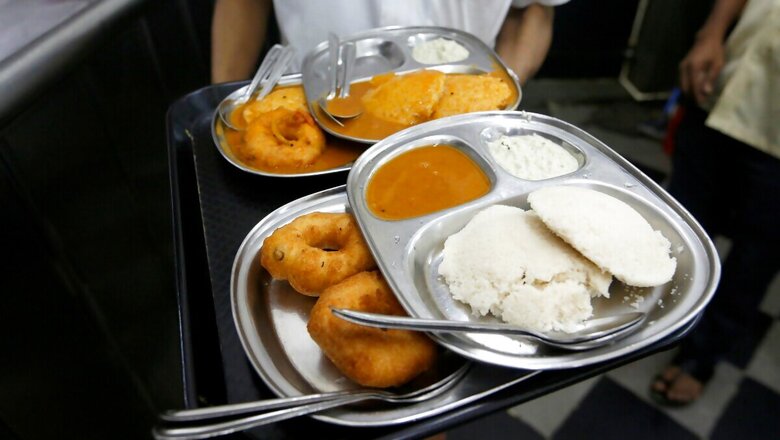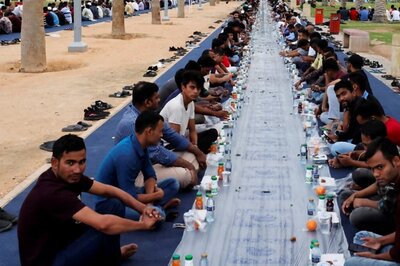
views
Idli and dosa, two of the most popular food items from South India, sparked a massive debate among Indians on Twitter after a Cambridge University professor and expert on India, Edward Anderson, claimed that “Idli are the most boring things in the world.”
The South Indians, after their filter coffee cuppa in the morning, sprang to the defense of their favourite breakfast staple. Anderson, after his October 7 tweet that led to the debate, followed it up with another message, saying, “Before the whole of South India attacks me, can I just say that I love dosa and appam and basically all south Indian food. But idli (and puttu for that matter) are insufferable.”
And who else but Congress leader and Thiruvananthapuram MP Shashi Tharoor to fiercely defend idli (pronounced also as idilly and idally) which he eats on most mornings, and the pictures of which he has tweeted from a Trivandrum hotel. Consoling his New York-based son Ishaan, who also found himself peeved by the anti-idli “most offensive tweet”, Shashi took a ‘civilisation’ leap: “Yes, my son, there are some who are truly challenged in this world. Civilisation is hard to acquire: the taste & refinement to appreciate idlis, enjoy cricket, or watch ottamthullal is not given to every mortal. Take pity on this poor man, for he may never know what Life can be.”
Yes, my son, there are some who are truly challenged in this world. Civilisation is hard to acquire: the taste & refinement to appreciate idlis, enjoy cricket, or watch ottamthullal is not given to every mortal. Take pity on this poor man, for he may never know what Life can be. https://t.co/M0rEfAU3V3— Shashi Tharoor (@ShashiTharoor) October 7, 2020
Faced with the torrent of critiques from idli fans around the world, Anderson ordered idli for lunch the same day and tweeted the picture in the hope that south India will not rise in rebellion. The debate soon turned into what it takes to make idli a fabulous dish. Classical singer TM Krishna jumped into the fray with the speed of fingers running across the tabla and said that Malayalees do not know how to make sambar, which goes well with idli, and after Tamils it is only the Kannadigas who can make the idli-sambar combo deliciously. Many will agree with this sambarian view.
Well, it can safely be said that both idli and dosa do not have a separate existence and work only with the paraphernalia of side dishes that go with it — the main accompaniments being chutney and sambar (which no one outside South Indian can pronounce and which is announced as saambhar in the north). Coconut chutney, which is an essential side dish, has mostly been given the go-by. Although Malayalees make up for the lack of fluffy idly expertise by making the best coconut chutneys. Dal chutney have become the favourite side dish in most of south Indian hotels, although if it is sambar, it has to be tasted in Tamil Nadu without doubt.
Some say the expertise in making sambar rests solely with certain Tamil Brahmin families and many others have improved on it considerably, with the button onion variety taking the cake. The problem with sambar in many places is that the tamarind or the button onion used in the south is not easily available elsewhere. And once that is done away with, the sambar goes for a watery toss. Add to it a terribly mixed idli and the damage is done. The lack of coconut chutney and the orthodox sambar is sought to be neutralised with various other chutneys, including pudina, tomato and the rest, making the humble dish into a multi-coloured thali.
Idli and dosa, however, have held their own even in the north India (thanks to Saravana Bhavan and some other popular ‘idli-dosa’ joints as they are referred to in the north from where I write) despite the rather shameful watery sambar served alongside. Idli served at most places and surely in London too is also a pathetic imitation of the real fluffy idlis that you can get anywhere in Chennai. With a slight brownish tint (perhaps due to the dal used) such idlis are likely to bring out the worst in some people as it happened with professor Anderson whose second tweet on idli had the picture of the slightly brownish piece at a London restaurant. The readymade Idli and dosa mixture popularised by MTR seems to be the main culprit behind the production of stale idlis and dosas. The fluffy idli has to perforce be mixed at home in the right proportions.
Dosa, too, is an immaculate culinary art and the various versions of it are to die for. Those who have tried making it have giving up in despair. To get the crispy outside is a task that takes many years to master. Dosa, due to its easily adaptability (egg, masala and onion varieties), seems to have surpassed idli in its popularity though the humble idli’s many modern versions, topped with bizarre ingredients like tomato, nuts, capsicum, in a ruse copied from pizza toppings, are drawing in new audiences.
South Indians will complain that professor Anderson, sitting in Cambridge, has hit the idli on its solar plexus, as if the British crime of converting the rasam or mulagutaneer into Mulligatawny soup was not enough. But try suggesting that idli is the worst dish and south India will break into a batter.
Read all the Latest News and Breaking News here


















Comments
0 comment